Luyu Gao
Probing the Critical Point (CritPt) of AI Reasoning: a Frontier Physics Research Benchmark
Oct 01, 2025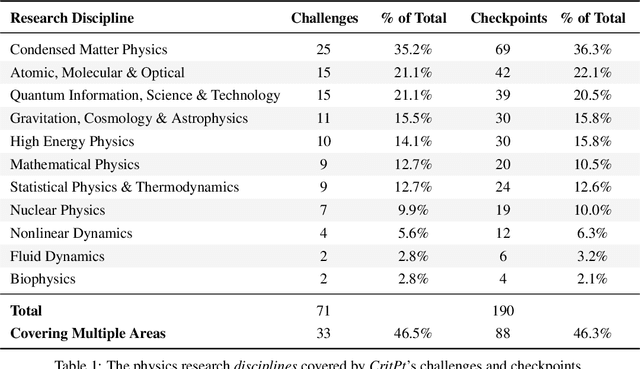
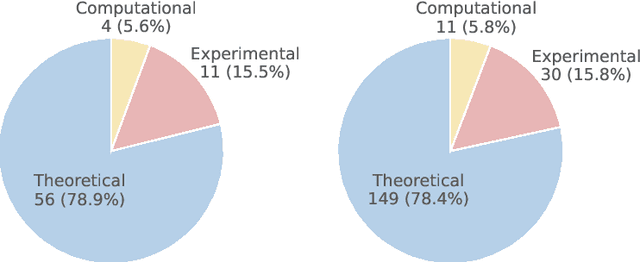
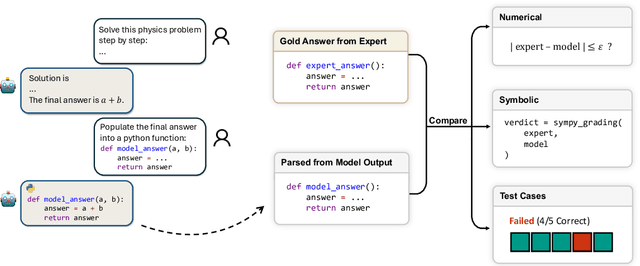
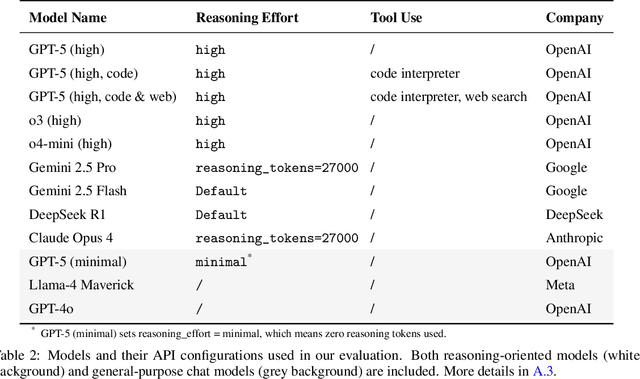
Abstract:While large language models (LLMs) with reasoning capabilities are progressing rapidly on high-school math competitions and coding, can they reason effectively through complex, open-ended challenges found in frontier physics research? And crucially, what kinds of reasoning tasks do physicists want LLMs to assist with? To address these questions, we present the CritPt (Complex Research using Integrated Thinking - Physics Test, pronounced "critical point"), the first benchmark designed to test LLMs on unpublished, research-level reasoning tasks that broadly covers modern physics research areas, including condensed matter, quantum physics, atomic, molecular & optical physics, astrophysics, high energy physics, mathematical physics, statistical physics, nuclear physics, nonlinear dynamics, fluid dynamics and biophysics. CritPt consists of 71 composite research challenges designed to simulate full-scale research projects at the entry level, which are also decomposed to 190 simpler checkpoint tasks for more fine-grained insights. All problems are newly created by 50+ active physics researchers based on their own research. Every problem is hand-curated to admit a guess-resistant and machine-verifiable answer and is evaluated by an automated grading pipeline heavily customized for advanced physics-specific output formats. We find that while current state-of-the-art LLMs show early promise on isolated checkpoints, they remain far from being able to reliably solve full research-scale challenges: the best average accuracy among base models is only 4.0% , achieved by GPT-5 (high), moderately rising to around 10% when equipped with coding tools. Through the realistic yet standardized evaluation offered by CritPt, we highlight a large disconnect between current model capabilities and realistic physics research demands, offering a foundation to guide the development of scientifically grounded AI tools.
Voxtral
Jul 17, 2025Abstract:We present Voxtral Mini and Voxtral Small, two multimodal audio chat models. Voxtral is trained to comprehend both spoken audio and text documents, achieving state-of-the-art performance across a diverse range of audio benchmarks, while preserving strong text capabilities. Voxtral Small outperforms a number of closed-source models, while being small enough to run locally. A 32K context window enables the model to handle audio files up to 40 minutes in duration and long multi-turn conversations. We also contribute three benchmarks for evaluating speech understanding models on knowledge and trivia. Both Voxtral models are released under Apache 2.0 license.
Magistral
Jun 12, 2025



Abstract:We introduce Magistral, Mistral's first reasoning model and our own scalable reinforcement learning (RL) pipeline. Instead of relying on existing implementations and RL traces distilled from prior models, we follow a ground up approach, relying solely on our own models and infrastructure. Notably, we demonstrate a stack that enabled us to explore the limits of pure RL training of LLMs, present a simple method to force the reasoning language of the model, and show that RL on text data alone maintains most of the initial checkpoint's capabilities. We find that RL on text maintains or improves multimodal understanding, instruction following and function calling. We present Magistral Medium, trained for reasoning on top of Mistral Medium 3 with RL alone, and we open-source Magistral Small (Apache 2.0) which further includes cold-start data from Magistral Medium.
Tevatron 2.0: Unified Document Retrieval Toolkit across Scale, Language, and Modality
May 05, 2025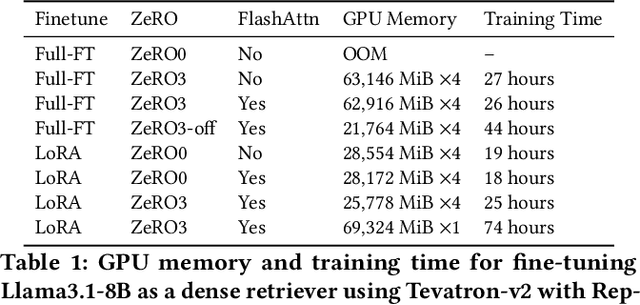
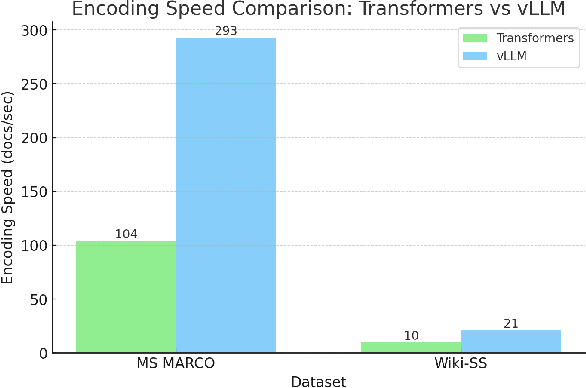
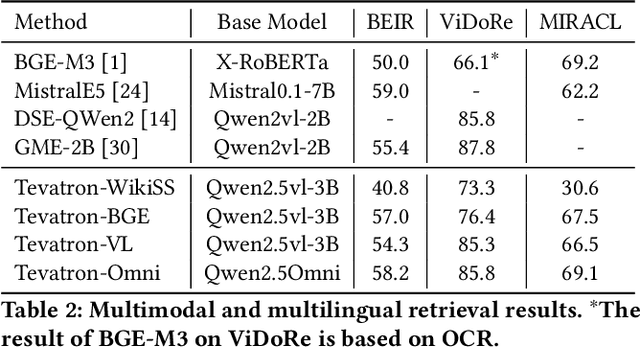
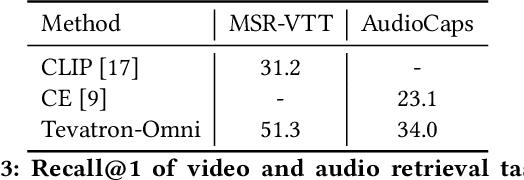
Abstract:Recent advancements in large language models (LLMs) have driven interest in billion-scale retrieval models with strong generalization across retrieval tasks and languages. Additionally, progress in large vision-language models has created new opportunities for multimodal retrieval. In response, we have updated the Tevatron toolkit, introducing a unified pipeline that enables researchers to explore retriever models at different scales, across multiple languages, and with various modalities. This demo paper highlights the toolkit's key features, bridging academia and industry by supporting efficient training, inference, and evaluation of neural retrievers. We showcase a unified dense retriever achieving strong multilingual and multimodal effectiveness, and conduct a cross-modality zero-shot study to demonstrate its research potential. Alongside, we release OmniEmbed, to the best of our knowledge, the first embedding model that unifies text, image document, video, and audio retrieval, serving as a baseline for future research.
Repository-level Code Search with Neural Retrieval Methods
Feb 10, 2025
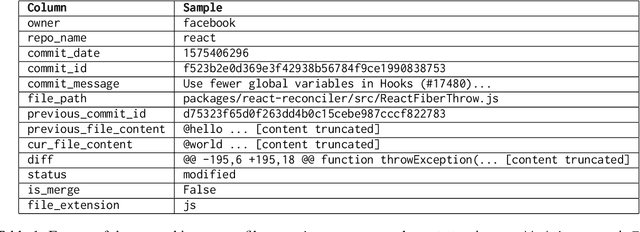


Abstract:This paper presents a multi-stage reranking system for repository-level code search, which leverages the vastly available commit histories of large open-source repositories to aid in bug fixing. We define the task of repository-level code search as retrieving the set of files from the current state of a code repository that are most relevant to addressing a user's question or bug. The proposed approach combines BM25-based retrieval over commit messages with neural reranking using CodeBERT to identify the most pertinent files. By learning patterns from diverse repositories and their commit histories, the system can surface relevant files for the task at hand. The system leverages both commit messages and source code for relevance matching, and is evaluated in both normal and oracle settings. Experiments on a new dataset created from 7 popular open-source repositories demonstrate substantial improvements of up to 80% in MAP, MRR and P@1 over the BM25 baseline, across a diverse set of queries, demonstrating the effectiveness this approach. We hope this work aids LLM agents as a tool for better code search and understanding. Our code and results obtained are publicly available.
ACER: Automatic Language Model Context Extension via Retrieval
Oct 11, 2024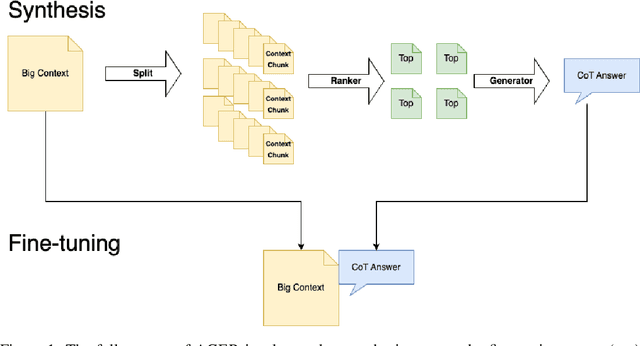
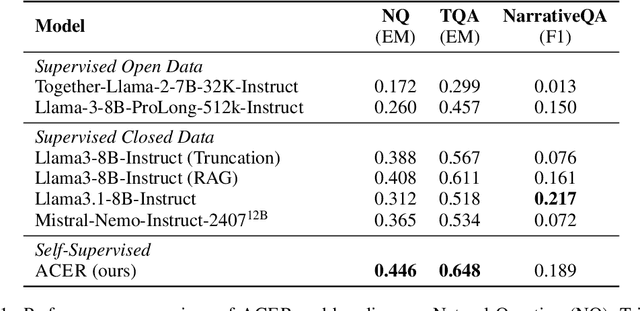
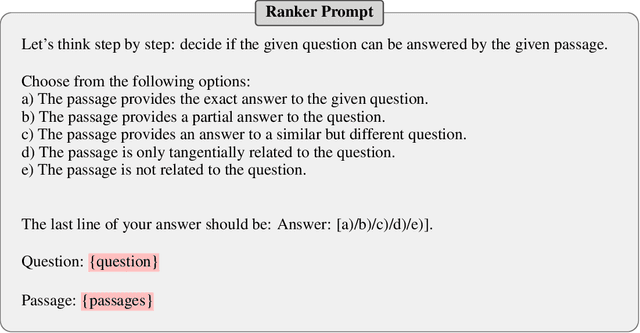
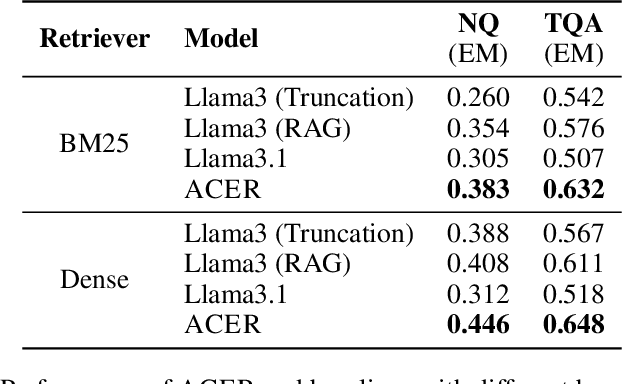
Abstract:Long-context modeling is one of the critical capabilities of language AI for digesting and reasoning over complex information pieces. In practice, long-context capabilities are typically built into a pre-trained language model~(LM) through a carefully designed context extension stage, with the goal of producing generalist long-context capabilities. In our preliminary experiments, however, we discovered that the current open-weight generalist long-context models are still lacking in practical long-context processing tasks. While this means perfectly effective long-context modeling demands task-specific data, the cost can be prohibitive. In this paper, we draw inspiration from how humans process a large body of information: a lossy \textbf{retrieval} stage ranks a large set of documents while the reader ends up reading deeply only the top candidates. We build an \textbf{automatic} data synthesis pipeline that mimics this process using short-context LMs. The short-context LMs are further tuned using these self-generated data to obtain task-specific long-context capabilities. Similar to how pre-training learns from imperfect data, we hypothesize and further demonstrate that the short-context model can bootstrap over the synthetic data, outperforming not only long-context generalist models but also the retrieval and read pipeline used to synthesize the training data in real-world tasks such as long-context retrieval augmented generation.
SciCode: A Research Coding Benchmark Curated by Scientists
Jul 18, 2024



Abstract:Since language models (LMs) now outperform average humans on many challenging tasks, it has become increasingly difficult to develop challenging, high-quality, and realistic evaluations. We address this issue by examining LMs' capabilities to generate code for solving real scientific research problems. Incorporating input from scientists and AI researchers in 16 diverse natural science sub-fields, including mathematics, physics, chemistry, biology, and materials science, we created a scientist-curated coding benchmark, SciCode. The problems in SciCode naturally factorize into multiple subproblems, each involving knowledge recall, reasoning, and code synthesis. In total, SciCode contains 338 subproblems decomposed from 80 challenging main problems. It offers optional descriptions specifying useful scientific background information and scientist-annotated gold-standard solutions and test cases for evaluation. Claude3.5-Sonnet, the best-performing model among those tested, can solve only 4.6% of the problems in the most realistic setting. We believe that SciCode demonstrates both contemporary LMs' progress towards becoming helpful scientific assistants and sheds light on the development and evaluation of scientific AI in the future.
FLAME: Factuality-Aware Alignment for Large Language Models
May 02, 2024



Abstract:Alignment is a standard procedure to fine-tune pre-trained large language models (LLMs) to follow natural language instructions and serve as helpful AI assistants. We have observed, however, that the conventional alignment process fails to enhance the factual accuracy of LLMs, and often leads to the generation of more false facts (i.e. hallucination). In this paper, we study how to make the LLM alignment process more factual, by first identifying factors that lead to hallucination in both alignment steps:\ supervised fine-tuning (SFT) and reinforcement learning (RL). In particular, we find that training the LLM on new knowledge or unfamiliar texts can encourage hallucination. This makes SFT less factual as it trains on human labeled data that may be novel to the LLM. Furthermore, reward functions used in standard RL can also encourage hallucination, because it guides the LLM to provide more helpful responses on a diverse set of instructions, often preferring longer and more detailed responses. Based on these observations, we propose factuality-aware alignment, comprised of factuality-aware SFT and factuality-aware RL through direct preference optimization. Experiments show that our proposed factuality-aware alignment guides LLMs to output more factual responses while maintaining instruction-following capability.
In-Context Principle Learning from Mistakes
Feb 09, 2024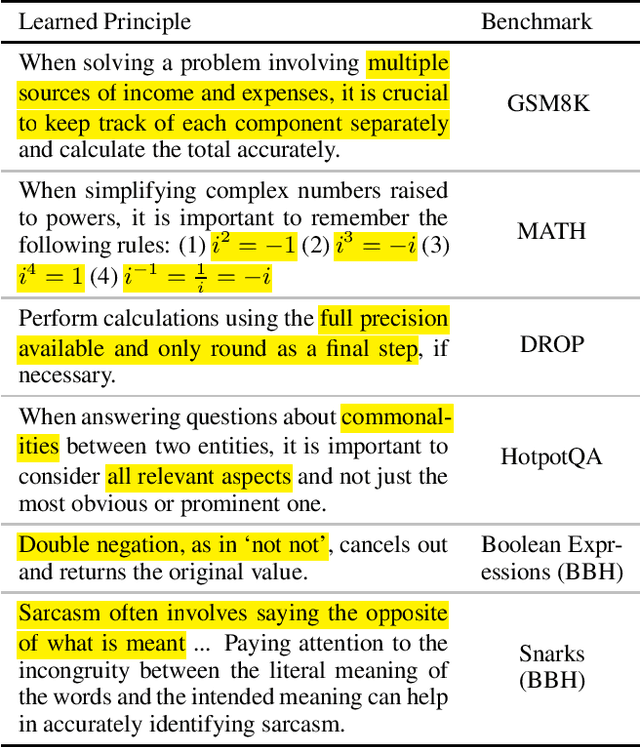


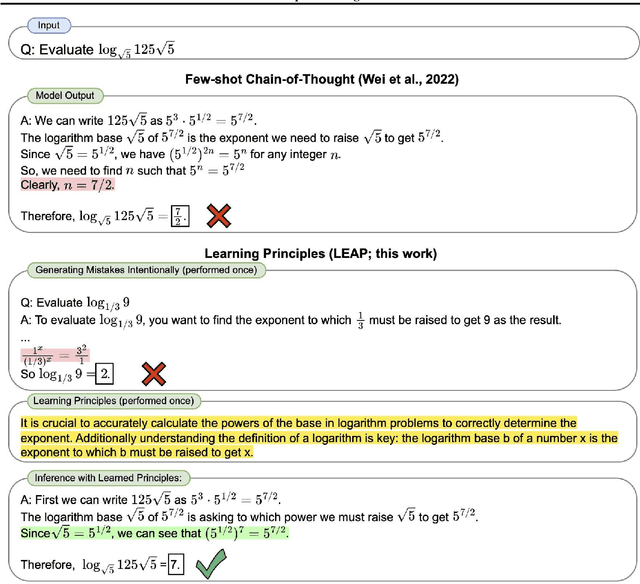
Abstract:In-context learning (ICL, also known as few-shot prompting) has been the standard method of adapting LLMs to downstream tasks, by learning from a few input-output examples. Nonetheless, all ICL-based approaches only learn from correct input-output pairs. In this paper, we revisit this paradigm, by learning more from the few given input-output examples. We introduce Learning Principles (LEAP): First, we intentionally induce the model to make mistakes on these few examples; then we reflect on these mistakes, and learn explicit task-specific "principles" from them, which help solve similar problems and avoid common mistakes; finally, we prompt the model to answer unseen test questions using the original few-shot examples and these learned general principles. We evaluate LEAP on a wide range of benchmarks, including multi-hop question answering (Hotpot QA), textual QA (DROP), Big-Bench Hard reasoning, and math problems (GSM8K and MATH); in all these benchmarks, LEAP improves the strongest available LLMs such as GPT-3.5-turbo, GPT-4, GPT-4 turbo and Claude-2.1. For example, LEAP improves over the standard few-shot prompting using GPT-4 by 7.5% in DROP, and by 3.3% in HotpotQA. Importantly, LEAP does not require any more input or examples than the standard few-shot prompting settings.
A Self-enhancement Approach for Domain-specific Chatbot Training via Knowledge Mining and Digest
Nov 17, 2023



Abstract:Large Language Models (LLMs), despite their great power in language generation, often encounter challenges when dealing with intricate and knowledge-demanding queries in specific domains. This paper introduces a novel approach to enhance LLMs by effectively extracting the relevant knowledge from domain-specific textual sources, and the adaptive training of a chatbot with domain-specific inquiries. Our two-step approach starts from training a knowledge miner, namely LLMiner, which autonomously extracts Question-Answer pairs from relevant documents through a chain-of-thought reasoning process. Subsequently, we blend the mined QA pairs with a conversational dataset to fine-tune the LLM as a chatbot, thereby enriching its domain-specific expertise and conversational capabilities. We also developed a new evaluation benchmark which comprises four domain-specific text corpora and associated human-crafted QA pairs for testing. Our model shows remarkable performance improvement over generally aligned LLM and surpasses domain-adapted models directly fine-tuned on domain corpus. In particular, LLMiner achieves this with minimal human intervention, requiring only 600 seed instances, thereby providing a pathway towards self-improvement of LLMs through model-synthesized training data.
 Add to Chrome
Add to Chrome Add to Firefox
Add to Firefox Add to Edge
Add to Edge